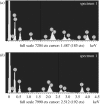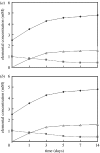Comparison of physical, chemical and cellular responses to nano- and micro-sized calcium silicate/poly(epsilon-caprolactone) bioactive composites
- PMID: 17999948
- PMCID: PMC3226988
- DOI: 10.1098/rsif.2007.1267
Comparison of physical, chemical and cellular responses to nano- and micro-sized calcium silicate/poly(epsilon-caprolactone) bioactive composites
Abstract
In this study, we fabricated nano-sized calcium silicate/poly(epsilon-caprolactone) composite (n-CPC) and micro-sized calcium silicate/poly(epsilon-caprolactone) composite (m-CPC). The composition, mechanical properties, hydrophilicity and degradability of both n-CPC and m-CPC were determined, and in vitro bioactivity was evaluated by investigating apatite forming on their surfaces in simulated body fluid (SBF). In addition, cell responses to the two kinds of composites were comparably investigated. The results indicated that n-CPC has superior hydrophilicity, compressive strength and elastic modulus properties compared with m-CPC. Both n-CPC and m-CPC exhibited good in vitro bioactivity, with different morphologies of apatite formation on their surfaces. The apatite layer on n-CPC was more homogeneous and compact than on m-CPC, due to the elevated levels of calcium and silicon concentrations in SBF from n-CPC throughout the 14-day soaking period. Significantly higher levels of attachment and proliferation of MG63 cells were observed on n-CPC than on m-CPC, and significantly higher levels of alkaline phosphatase activity were observed in human mesenchymal stem cells (hMSCs) on n-CPC than on m-CPC after 7 days. Scanning electron microscopy observations revealed that hMSCs were in intimate contact with both n-CPC and m-CPC surfaces, and significantly cell adhesion, spread and growth were observed on n-CPC and m-CPC. These results indicated that both n-CPC and m-CPC have the ability to support cell attachment, growth, proliferation and differentiation, and also yield good bioactivity and biocompatibility.
Figures













Similar articles
-
Preparation and characterization of bioactive mesoporous wollastonite - Polycaprolactone composite scaffold.Biomaterials. 2009 Feb;30(6):1080-8. doi: 10.1016/j.biomaterials.2008.10.046. Epub 2008 Nov 18. Biomaterials. 2009. PMID: 19019424
-
Preparation, characterization, in vitro bioactivity, and cellular responses to a polyetheretherketone bioactive composite containing nanocalcium silicate for bone repair.ACS Appl Mater Interfaces. 2014 Aug 13;6(15):12214-25. doi: 10.1021/am504409q. Epub 2014 Jul 24. ACS Appl Mater Interfaces. 2014. PMID: 25013988
-
Preparation and characterization of bioactive calcium silicate and poly(epsilon-caprolactone) nanocomposite for bone tissue regeneration.J Biomed Mater Res A. 2009 Sep 1;90(3):702-12. doi: 10.1002/jbm.a.32139. J Biomed Mater Res A. 2009. PMID: 18563819
-
Mesoporous magnesium silicate-incorporated poly(ε-caprolactone)-poly(ethylene glycol)-poly(ε-caprolactone) bioactive composite beneficial to osteoblast behaviors.Int J Nanomedicine. 2014 May 27;9:2665-75. doi: 10.2147/IJN.S59040. eCollection 2014. Int J Nanomedicine. 2014. PMID: 24920903 Free PMC article.
-
Comparative in vitro and in vivo studies using a bioactive poly(epsilon-caprolactone)-organosiloxane nanohybrid containing calcium salt.J Biomed Mater Res B Appl Biomater. 2007 Oct;83(1):189-98. doi: 10.1002/jbm.b.30783. J Biomed Mater Res B Appl Biomater. 2007. PMID: 17385222
Cited by
-
Biocompatibility, degradability, bioactivity and osteogenesis of mesoporous/macroporous scaffolds of mesoporous diopside/poly(L-lactide) composite.J R Soc Interface. 2015 Oct 6;12(111):20150507. doi: 10.1098/rsif.2015.0507. J R Soc Interface. 2015. PMID: 26378120 Free PMC article.
-
Degradable biocomposite of nano calcium-deficient hydroxyapatite-multi(amino acid) copolymer.Int J Nanomedicine. 2012;7:1287-95. doi: 10.2147/IJN.S28978. Epub 2012 Mar 8. Int J Nanomedicine. 2012. PMID: 22457591 Free PMC article.
-
Preparation and characterization of mesoporous bioactive glass/polycaprolactone nanofibrous matrix for bone tissues engineering.J Mater Sci Mater Med. 2012 Nov;23(11):2619-30. doi: 10.1007/s10856-012-4734-z. Epub 2012 Aug 9. J Mater Sci Mater Med. 2012. PMID: 22875607
-
Fabrication and Characteristics of PCL Membranes Containing Strontium-Substituted Hydroxyapatite Nanofibers for Guided Bone Regeneration.Polymers (Basel). 2019 Oct 27;11(11):1761. doi: 10.3390/polym11111761. Polymers (Basel). 2019. PMID: 31717839 Free PMC article.
-
Plasma-sprayed CaTiSiO5 ceramic coating on Ti-6Al-4V with excellent bonding strength, stability and cellular bioactivity.J R Soc Interface. 2009 Feb 6;6(31):159-68. doi: 10.1098/rsif.2008.0274. J R Soc Interface. 2009. PMID: 18664431 Free PMC article.
References
-
- Chou L, Al-Bazie S, Cottrell D, Giordano R, Nathason D. Atomic and molecular mechanisms underlying the osteogenic effects of Bioglass materials. Bioceramics. 1998;11:265–268.
-
- Keeting, P. E., Wiegand, K. E., Spelssberg, T. C. & Riggs, B. L. 2002 A novel silicon-containing osteotropic agent, zeolite A, induces proliferation and differentiation of normal human osteoblastlike cells. In American Society for Bone and Mineral Research Annual Meeting, Atlanta, GA, abstract 184.
Publication types
MeSH terms
Substances
LinkOut - more resources
Full Text Sources

